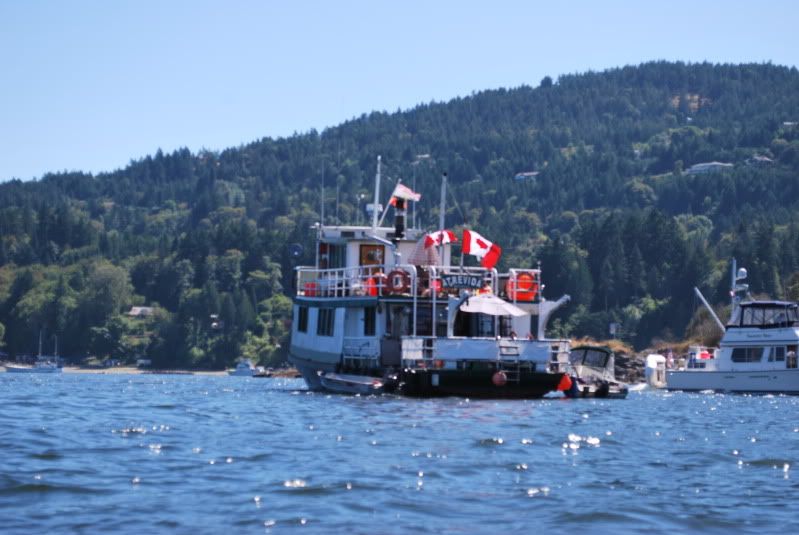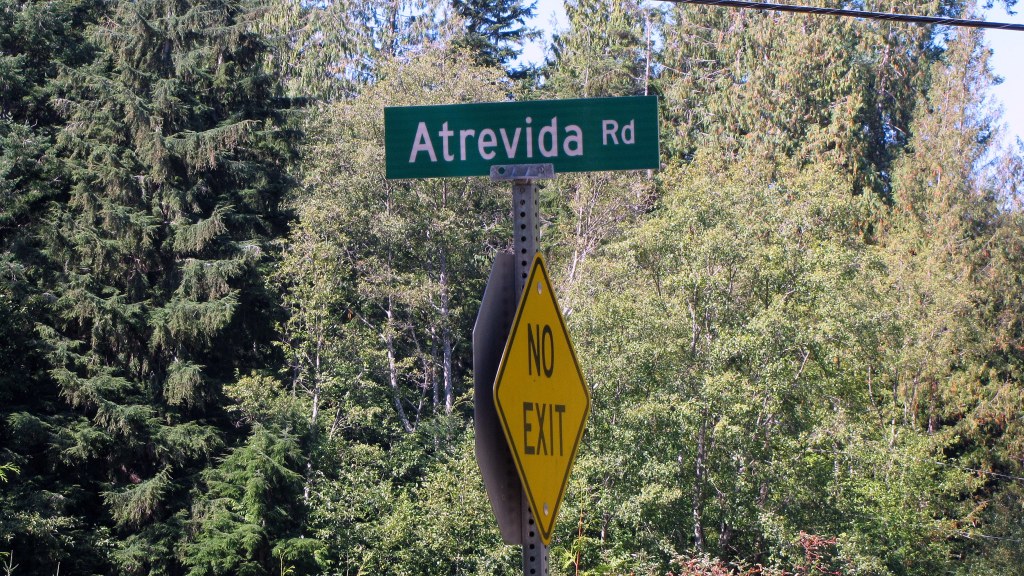Post by D'Elete BC in NJ on Jun 11, 2008 9:41:25 GMT -8
After send the link to the Atrevida I posted to another thread to my dad, I got the following photos back:
This first one, likely taken from the Tachek, probably dates to 1969, right after the Atrevida was retired from the run. I think this is my dad's photo, but I have to ask him.

This second photo is from the Powell River Peak, though I haven't found a credit to a particular photographer.

1955 TO 1969: Atrevida made three runs a day carrying up to five cars and 40 passengers. Runs were later added through subsidizing by the ministry of transportation and highways.
www.zwire.com/site/news.cfm?newsid=14590612&BRD=1998&PAG=461&dept_id=221589&rfi=6
Texada ferry turns 50
Ted Durnin, Peak Reporter
05/25/2005
From water taxi to a Canadian Pacific Railway route to a ministry-subsidized ferry service, getting back and forth from Texada Island has always been a trip
A ferry system that made it possible for Texada Island residents to easily drive off the island is turning 50 this month.
BC Ferries is celebrating the Texada route's 50th anniversary aboard the North Island Princess and at the Westview Ferry Terminal from 9 am to 6 pm on Saturday, May 28. Visitors can check out a Texada Historical Society display on the ferry. Refreshments and activities will also be part of the celebration.
Before subsidized ferry service to Texada began, a diverse collection of other outfits provided service to the island.
In the early days of mill construction, Powell River Company's Charmer flew the checkerboard flag. From 1918 until 1951, Bill Young ran a water taxi named Louvain, which Bill Cottingham continued until 1953. Ben Nicholas began another water taxi service to Texada in 1952 in Lady Slipper, later adding Blue Belle and Moccasin. The three water taxis ran from 4 am to 11:30 pm most days that year, said Nicholas, transporting crews working on construction of electrical upgrades at the mine and running hydro lines from the mainland.
Tidewater Shipping's Gulf series of vessels also provided passenger service in the Malaspina Strait before 1955. On October 11, 1947, the Gulf Stream struck Dinner Rock and went down, with five lives lost.
"After that, we could go as foot passengers on the Gulf Mariner," a smaller vessel, said former Texada resident Ron Beauchamp.
Until the end of 1954, Canadian Pacific Railway (CPR) boats such as the Princess Beatrice, Princess Mary, and Princess Elaine were the main transportation to Texada. They would load in Blubber Bay at 4 pm and at the mill until 11 pm.
"The next morning, you'd wake up in Vancouver," said Beau-champ. Cargo often took priority over passengers, leaving people standing at the dock.
With Queen Charlotte Airlines starting air service to Powell River in 1952, and Black Ball Ferries Ltd. extending the highway with a ferry across Jervis Inlet, CPR withdrew service on April 18, 1954. Three passenger trips a week continued on Tidewater Shipping's Gulf Wing and Gulf Mariner, and Union Steamship Ltd.'s Capilano provided freight service. Vessels often arrived at Texada fully loaded, and had to leave people and cars behind.
The Atrevida sailed for the first time from Blubber Bay on May 28, 1955, offering the first regular, ministry of transportation and highways-subsidized ferry service to Texada Island. The Atrevida was a five-car, 40-passenger vessel that had been on the Gabriola Island route. In 1967 or so, the ministry entered into an interim agreement or partnership with the Atrevida, and increased the number of runs, Beau-champ said.
In 1969 the Texada Queen, later renamed the Tachek, was put on the route. The Tachek could take larger vehicles than the Atrevida. "We always called it the Paycheck," said former Texada Queen deckhand Roy Ditto.
"Texada [residents] thought they owned it," he added. "It was a little more informal, when it was [ministry of transportation and] highways. If someone came to the dock and waved to us, we'd go back for them."
Ditto also worked on the larger North Island Princess, which has been on the run since 1979. BC Ferries took over the route from the ministry of transportation in 1985.
As time went by and crews rotated, the feeling of family lessened, said Ditto. He mentioned that the North Gulf Islands were called the "North Goofy Islands" by some of the visitors from more conventional runs, such as Horseshoe Bay, "because we acted like a bunch of hillbillies."
Ditto also credits a visit from then-minister of transportation Grace McCarthy with the appearance of uniforms for BC Ferries crews, which he said was inspired by his crew's "slovenly appearance."
There was a saying used right up to the 1960s at the mill, said Beauchamp, that harkened back to the days of the CPR Princesses. When someone pulled a gaffe, a co-worker would ask, "What, did you just get off the Mary?"
Another photo of the present day Atrevida, and a little description of her present day activities:
www.epiphyte.ca/weblog/2005/07/20050711.html
This first one, likely taken from the Tachek, probably dates to 1969, right after the Atrevida was retired from the run. I think this is my dad's photo, but I have to ask him.

This second photo is from the Powell River Peak, though I haven't found a credit to a particular photographer.

1955 TO 1969: Atrevida made three runs a day carrying up to five cars and 40 passengers. Runs were later added through subsidizing by the ministry of transportation and highways.
www.zwire.com/site/news.cfm?newsid=14590612&BRD=1998&PAG=461&dept_id=221589&rfi=6
Texada ferry turns 50
Ted Durnin, Peak Reporter
05/25/2005
From water taxi to a Canadian Pacific Railway route to a ministry-subsidized ferry service, getting back and forth from Texada Island has always been a trip
A ferry system that made it possible for Texada Island residents to easily drive off the island is turning 50 this month.
BC Ferries is celebrating the Texada route's 50th anniversary aboard the North Island Princess and at the Westview Ferry Terminal from 9 am to 6 pm on Saturday, May 28. Visitors can check out a Texada Historical Society display on the ferry. Refreshments and activities will also be part of the celebration.
Before subsidized ferry service to Texada began, a diverse collection of other outfits provided service to the island.
In the early days of mill construction, Powell River Company's Charmer flew the checkerboard flag. From 1918 until 1951, Bill Young ran a water taxi named Louvain, which Bill Cottingham continued until 1953. Ben Nicholas began another water taxi service to Texada in 1952 in Lady Slipper, later adding Blue Belle and Moccasin. The three water taxis ran from 4 am to 11:30 pm most days that year, said Nicholas, transporting crews working on construction of electrical upgrades at the mine and running hydro lines from the mainland.
Tidewater Shipping's Gulf series of vessels also provided passenger service in the Malaspina Strait before 1955. On October 11, 1947, the Gulf Stream struck Dinner Rock and went down, with five lives lost.
"After that, we could go as foot passengers on the Gulf Mariner," a smaller vessel, said former Texada resident Ron Beauchamp.
Until the end of 1954, Canadian Pacific Railway (CPR) boats such as the Princess Beatrice, Princess Mary, and Princess Elaine were the main transportation to Texada. They would load in Blubber Bay at 4 pm and at the mill until 11 pm.
"The next morning, you'd wake up in Vancouver," said Beau-champ. Cargo often took priority over passengers, leaving people standing at the dock.
With Queen Charlotte Airlines starting air service to Powell River in 1952, and Black Ball Ferries Ltd. extending the highway with a ferry across Jervis Inlet, CPR withdrew service on April 18, 1954. Three passenger trips a week continued on Tidewater Shipping's Gulf Wing and Gulf Mariner, and Union Steamship Ltd.'s Capilano provided freight service. Vessels often arrived at Texada fully loaded, and had to leave people and cars behind.
The Atrevida sailed for the first time from Blubber Bay on May 28, 1955, offering the first regular, ministry of transportation and highways-subsidized ferry service to Texada Island. The Atrevida was a five-car, 40-passenger vessel that had been on the Gabriola Island route. In 1967 or so, the ministry entered into an interim agreement or partnership with the Atrevida, and increased the number of runs, Beau-champ said.
In 1969 the Texada Queen, later renamed the Tachek, was put on the route. The Tachek could take larger vehicles than the Atrevida. "We always called it the Paycheck," said former Texada Queen deckhand Roy Ditto.
"Texada [residents] thought they owned it," he added. "It was a little more informal, when it was [ministry of transportation and] highways. If someone came to the dock and waved to us, we'd go back for them."
Ditto also worked on the larger North Island Princess, which has been on the run since 1979. BC Ferries took over the route from the ministry of transportation in 1985.
As time went by and crews rotated, the feeling of family lessened, said Ditto. He mentioned that the North Gulf Islands were called the "North Goofy Islands" by some of the visitors from more conventional runs, such as Horseshoe Bay, "because we acted like a bunch of hillbillies."
Ditto also credits a visit from then-minister of transportation Grace McCarthy with the appearance of uniforms for BC Ferries crews, which he said was inspired by his crew's "slovenly appearance."
There was a saying used right up to the 1960s at the mill, said Beauchamp, that harkened back to the days of the CPR Princesses. When someone pulled a gaffe, a co-worker would ask, "What, did you just get off the Mary?"
Another photo of the present day Atrevida, and a little description of her present day activities:
www.epiphyte.ca/weblog/2005/07/20050711.html














